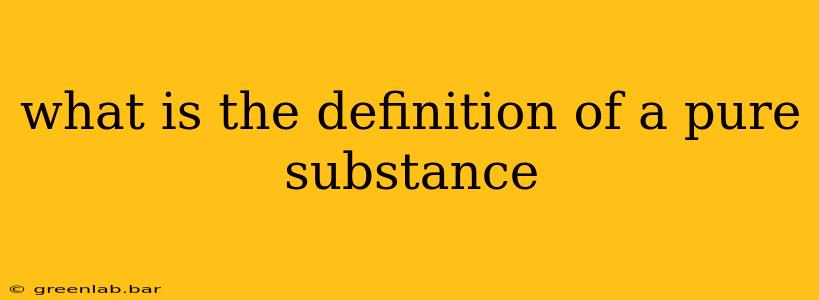A pure substance is a form of matter that has a constant chemical composition and properties throughout a given sample. This means that it's made up of only one type of atom or molecule and cannot be separated into simpler substances by physical methods like filtration, distillation, or evaporation. Understanding this definition requires delving into the key characteristics that distinguish pure substances from mixtures.
Key Characteristics of a Pure Substance
Several key characteristics define a pure substance:
-
Uniform Composition: A pure substance has the same composition throughout. Every part of the sample will have the identical chemical makeup. There's no variation in the types or proportions of the atoms or molecules present.
-
Specific Properties: Each pure substance has a unique set of physical and chemical properties. These properties, such as melting point, boiling point, density, and reactivity, can be used to identify and distinguish one pure substance from another. For instance, pure water always boils at 100°C (at standard atmospheric pressure), while a mixture of water and salt will boil at a higher temperature.
-
Fixed Composition: The ratio of elements in a pure substance is always constant. This is dictated by the chemical formula. For example, pure water (H₂O) always has a 2:1 ratio of hydrogen atoms to oxygen atoms.
-
Cannot be Separated by Physical Means: Pure substances cannot be separated into simpler components using physical methods. Mechanical separation techniques, like filtering or decanting, won't work. Only chemical methods, such as electrolysis (for compounds), can break them down.
Pure Substances vs. Mixtures
It's crucial to differentiate pure substances from mixtures. While a pure substance has a uniform composition, a mixture contains two or more different substances that are physically combined but not chemically bonded. Mixtures can be homogeneous (uniform throughout, like saltwater) or heterogeneous (non-uniform, like sand and water). Mixtures can be separated into their components through physical means.
Types of Pure Substances: Elements and Compounds
Pure substances fall into two main categories:
1. Elements
Elements are the simplest form of pure substances. They are made up of only one type of atom. These atoms all have the same number of protons in their nuclei. Examples include oxygen (O), iron (Fe), gold (Au), and hydrogen (H). Elements are found on the periodic table.
2. Compounds
Compounds are pure substances made up of two or more different elements chemically bonded together in a fixed ratio. This chemical bond forms a new substance with properties distinct from those of its constituent elements. Examples include water (H₂O), table salt (NaCl), and carbon dioxide (CO₂). Compounds can be broken down into simpler substances (their constituent elements) only through chemical means.
Conclusion
Understanding the definition of a pure substance is fundamental to chemistry and other scientific disciplines. Its defining characteristics—uniform composition, specific properties, fixed composition, and inability to be separated by physical means—distinguish it from mixtures and highlight the fundamental building blocks of matter. The distinction between elements and compounds further clarifies the diverse ways in which pure substances can exist.

